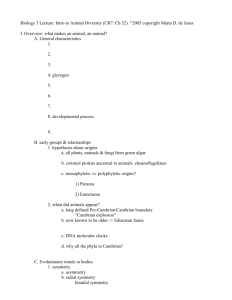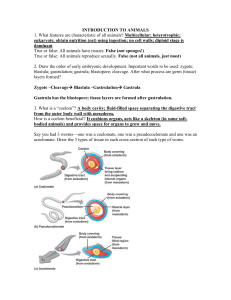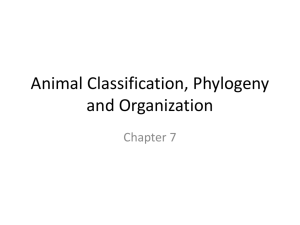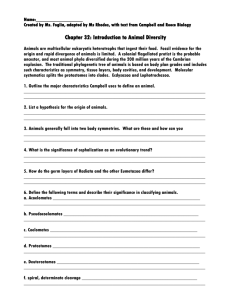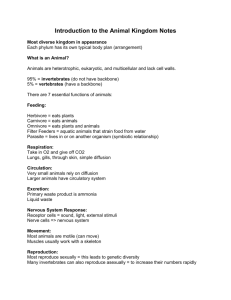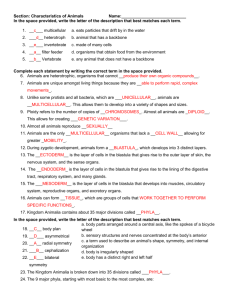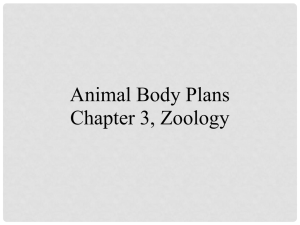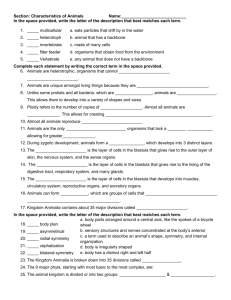Section 3: Evolutionary Trends in Animals
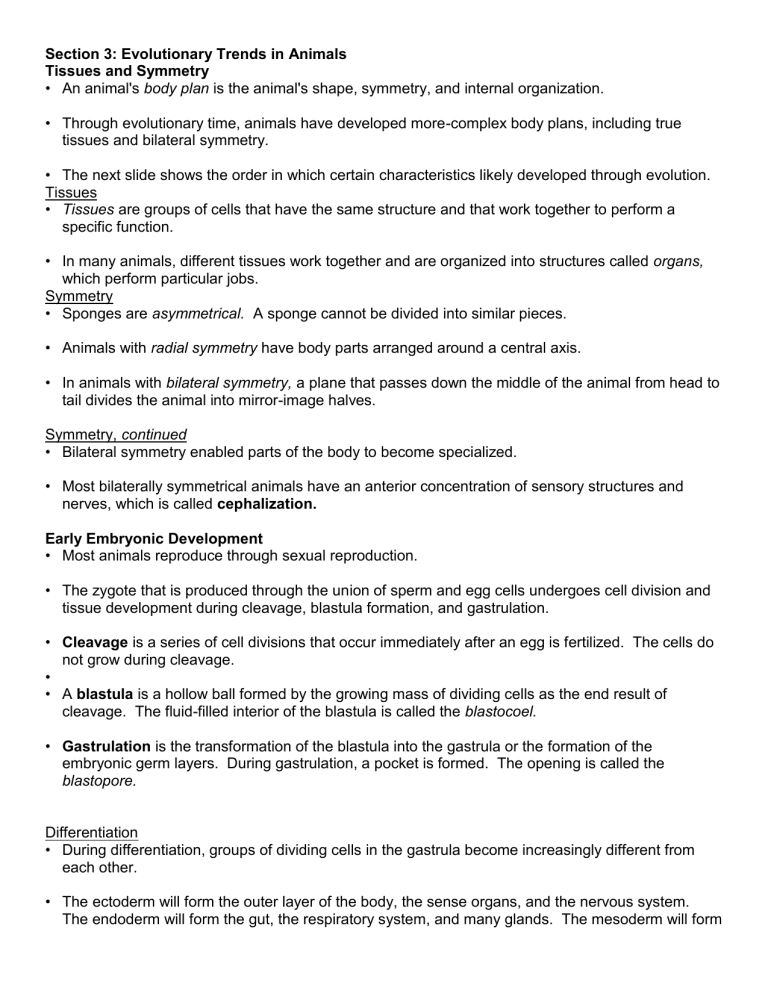
Section 3: Evolutionary Trends in Animals
Tissues and Symmetry
• An animal's body plan is the animal's shape, symmetry, and internal organization.
• Through evolutionary time, animals have developed more-complex body plans, including true tissues and bilateral symmetry.
• The next slide shows the order in which certain characteristics likely developed through evolution.
Tissues
•
Tissues are groups of cells that have the same structure and that work together to perform a specific function.
• In many animals, different tissues work together and are organized into structures called organs, which perform particular jobs.
Symmetry
• Sponges are asymmetrical.
A sponge cannot be divided into similar pieces.
• Animals with radial symmetry have body parts arranged around a central axis.
• In animals with bilateral symmetry, a plane that passes down the middle of the animal from head to tail divides the animal into mirror-image halves.
Symmetry, continued
• Bilateral symmetry enabled parts of the body to become specialized.
• Most bilaterally symmetrical animals have an anterior concentration of sensory structures and nerves, which is called cephalization.
Early Embryonic Development
• Most animals reproduce through sexual reproduction.
• The zygote that is produced through the union of sperm and egg cells undergoes cell division and tissue development during cleavage, blastula formation, and gastrulation.
•
Cleavage is a series of cell divisions that occur immediately after an egg is fertilized. The cells do not grow during cleavage.
•
• A blastula is a hollow ball formed by the growing mass of dividing cells as the end result of cleavage. The fluid-filled interior of the blastula is called the blastocoel.
•
Gastrulation is the transformation of the blastula into the gastrula or the formation of the embryonic germ layers. During gastrulation, a pocket is formed. The opening is called the blastopore.
Differentiation
• During differentiation, groups of dividing cells in the gastrula become increasingly different from each other.
• The ectoderm will form the outer layer of the body, the sense organs, and the nervous system.
The endoderm will form the gut, the respiratory system, and many glands. The mesoderm will form
most of the skeleton, the muscles, the circulatory system, and the organs of reproduction and excretion.
Patterns of Development
• The inward folding of the gastrula's pocket becomes deeper. Eventually, the pocket breaks through the side of the gastrula opposite the blastopore.
• This process changes the pocket into the gut of the developing embryo.
Patterns of Development, continued
• In some animal group's, called protostomes, the mouth develops from the end of the embryo near the blastopore. The anus develops at the opposite end.
• Flatworms, earthworms, snails and clams, spiders and insects, and their relatives are all protostomes.
Patterns of Development, continued
• In some animal group's, called deuterostomes, the mouth develops from the end of the embryo opposite the blastopore. The anus develops at or near the blastopore.
• Sea stars and their relatives and vertebrates and their relatives are all deuterostomes.
• The first deuterostomes evolved more than 650 million years ago. Deuterostomes were the first animals to develop endoskeletons.
Patterns of Animal Development
Body Cavities
• A coelom is a fluid-filled space that contains the internal organs between the body wall and the gut. Humans and other vertebrates have a coelom.
• Animals with no body cavity are called acoelomates.
Flatworms are acoelomates.
•
Pseudocoelomates have a body cavity located between the mesoderm and endoderm. This false coelom is filled with liquid that provides support. Flatworms are pseudocoelomates.
• Segmented worms and all other more "advanced" animals have a true coelom and are called coelomates.
• The gut and other internal organs of coelomates are suspended within the coelom.
• In coelomates, the mesoderm and endoderm can be in contact during embryonic development.
This contact was important for the evolution of complex organs.
• The coelom allows an animal to move without damaging its organs or interfering with their functions.
Segmentation and Jointed Appendages
• Body segmentation and jointed appendages gave animals a greater ability to move and to be flexible.
• Segmentation is obvious in some animals, such as earthworms or caterpillars. In other animals, such as vertebrates, the segments are visible only during early development.
• The muscles of vertebrates develop from segments of tissue called somites.
• Segmentation can allow great mobility and flexibility. For example, an earthworm can tie its body in knots.
• Segmentation also offers evolutionary flexibility. A small change in an existing segment can produce a new type of segment with a different function.
• Arthropods were the first animals to have jointed appendages. Jointed appendages allow animals to perform complex movements.
Summary
• Through evolutionary time, animals have developed more-complex body plans, including true tissues and bilateral symmetry.
• The steps of early embryonic development in animals include cleavage, blastula formation, and gastrulation.
• Animals with bilateral symmetry have one of three basic kinds of internal body plans. The body plan may include a body cavity, or coelom.
• The evolution of body segmentation and jointed appendages gave animals a greater ability to move and to be flexible.
